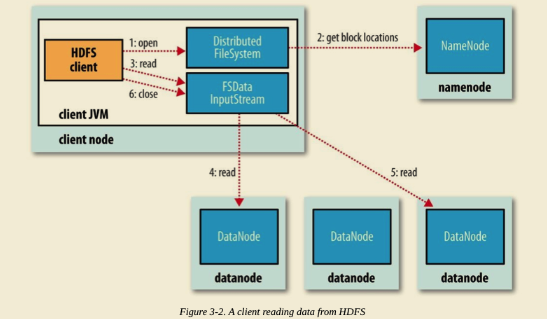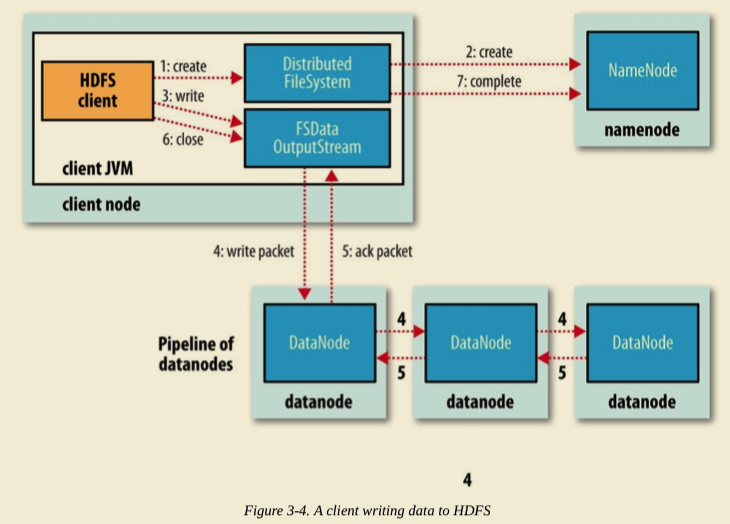HDFS 读写流程-英
HDFS 文件读取流程

The client opens the file it wishes to read by calling open() on the FileSystem object, which for HDFS is an instance of DistributedFileSystem (step 1 in Figure 3-2).
DistributedFileSystem calls the namenode, using remote procedure calls (RPCs), to determine the locations of the first few blocks in the file (step 2). For each block, the namenode returns the addresses of the datanodes that have a copy of that block.
Furthermore, the datanodes are sorted according to their proximity to the client (according to the topology of the cluster’s network;). If the client is itself a datanode (in the case of a MapReduce task, for instance), the client will read from the local datanode if that datanode hosts a copy of the block.
The DistributedFileSystem returns an FSDataInputStream (an input stream that supports file seeks) to the client for it to read data from. FSDataInputStream in turn wraps a DFSInputStream, which manages the datanode and namenode I/O.
The client then calls read() on the stream (step 3). DFSInputStream, which has stored the datanode addresses for the first few blocks in the file, then connects to the first (closest) datanode for the first block in the file. Data is streamed from the datanode back to the client, which calls read() repeatedly on the stream (step 4). When the end of the block is reached, DFSInputStream will close the connection to the datanode, then find the best datanode for the next block (step 5). This happens transparently to the client, which from its point of view is just reading a continuous stream.
Blocks are read in order, with the DFSInputStream opening new connections to datanodes as the client reads through the stream. It will also call the namenode to retrieve the datanode locations for the next batch of blocks as needed. When the client has finished reading, it calls close() on the FSDataInputStream (step 6).
During reading, if the DFSInputStream encounters an error while communicating with a datanode, it will try the next closest one for that block. It will also remember datanodes that have failed so that it doesn’t needlessly retry them for later blocks. The DFSInputStream also verifies checksums for the data transferred to it from the datanode.
If a corrupted block is found, the DFSInputStream attempts to read a replica of the block from another datanode; it also reports the corrupted block to the namenode.
One important aspect of this design is that the client contacts datanodes directly to retrieve data and is guided by the namenode to the best datanode for each block. This design allows HDFS to scale to a large number of concurrent clients because the data traffic is spread across all the datanodes in the cluster. Meanwhile, the namenode merely has to service block location requests (which it stores in memory, making them very efficient) and does not, for example, serve data, which would quickly become a bottleneck as the number of clients grew.
HDFS 文件写入流程

The client creates the file by calling create() on DistributedFileSystem (step 1 in Figure 3-4).
DistributedFileSystem makes an RPC call to the namenode to create a new file in the filesystem’s namespace, with no blocks associated with it (step 2). The namenode performs various checks to make sure the file doesn’t already exist and that the client has the right permissions to create the file. If these checks pass, the namenode makes a record of the new file; otherwise, file creation fails and the client is thrown an IOException. The DistributedFileSystem returns an FSDataOutputStream for the client to start writing data to. Just as in the read case, FSDataOutputStream wraps a DFSOutputStream, which handles communication with the datanodes and namenode.
As the client writes data (step 3), the DFSOutputStream splits it into packets, which it writes to an internal queue called the data queue. The data queue is consumed by the DataStreamer, which is responsible for asking the namenode to allocate new blocks by picking a list of suitable datanodes to store the replicas. The list of datanodes forms a pipeline, and here we’ll assume the replication level is three, so there are three nodes in the pipeline. The DataStreamer streams the packets to the first datanode in the pipeline, which stores each packet and forwards it to the second datanode in the pipeline. Similarly, the second datanode stores the packet and forwards it to the third (and last) datanode in the pipeline (step 4).
The DFSOutputStream also maintains an internal queue of packets that are waiting to be acknowledged by datanodes, called the ack queue. A packet is removed from the ack queue only when it has been acknowledged by all the datanodes in the pipeline (step 5).
If any datanode fails while data is being written to it, then the following actions are taken, which are transparent to the client writing the data. First, the pipeline is closed, and any packets in the ack queue are added to the front of the data queue so that datanodes that are downstream from the failed node will not miss any packets. The current block on the good datanodes is given a new identity, which is communicated to the namenode, so that the partial block on the failed datanode will be deleted if the failed datanode recovers later on.
The failed datanode is removed from the pipeline, and a new pipeline is constructed from the two good datanodes. The remainder of the block’s data is written to the good datanodes in the pipeline. The namenode notices that the block is under-replicated, and it arranges for a further replica to be created on another node. Subsequent blocks are then treated as normal.
When the client has finished writing data, it calls close() on the stream (step 6). This action flushes all the remaining packets to the datanode pipeline and waits for acknowledgments before contacting the namenode to signal that the file is complete (step 7). The namenode already knows which blocks the file is made up of (because DataStreamer asks for block allocations), so it only has to wait for blocks to be minimally replicated before returning successfully.
欢迎关注我的公众号

HDFS 读写流程-英的更多相关文章
- 大数据系列文章-Hadoop的HDFS读写流程(二)
在介绍HDFS读写流程时,先介绍下Block副本放置策略. Block副本放置策略 第一个副本:放置在上传文件的DataNode:如果是集群外提交,则随机挑选一台磁盘不太满,CPU不太忙的节点. 第二 ...
- 【转】HDFS读写流程
概述开始之前先看看其基本属性,HDFS(Hadoop Distributed File System)是GFS的开源实现. 特点如下: 能够运行在廉价机器上,硬件出错常态,需要具备高容错性流式数据访问 ...
- HDFS读写流程(转载)
概述开始之前先看看其基本属性,HDFS(Hadoop Distributed File System)是GFS的开源实现.特点如下: 能够运行在廉价机器上,硬件出错常态,需要具备高容错性 ...
- 超详细的HDFS读写流程详解(最容易理解的方式)
HDFS采用的是master/slaves这种主从的结构模型管理数据,这种结构模型主要由四个部分组成,分别是Client(客户端).Namenode(名称节点).Datanode(数据节点)和Seco ...
- Hadoop之HDFS读写流程
hadoophdfs 1. HDFS写流程 2. HDFS写流程 1. HDFS写流程 HDFS写流程 副本存放策略: 上传的数据块后,触发一个新的线程,进行存放. 第一个副本:与client最近的机 ...
- HDFS 读写流程-译
HDFS 文件读取流程 Client 端调用 DistributedFileSystem 对象的 open() 方法. 由 DistributedFileSystem 通过 RPC 向 NameNod ...
- HDFS读写流程(重点)
@ 目录 一.写数据流程 举例: 二.异常写流程 读数据流程 一.写数据流程 ①服务端启动HDFS中的NN和DN进程 ②客户端创建一个分布式文件系统客户端,由客户端向NN发送请求,请求上传文件 ③NN ...
- HDFS读写流程learning
有许多对流程进行描述的博客,但是感觉还是应当学习一遍代码,不然总感觉怪怪的,https://blog.csdn.net/popsuper1982/article/details/51615285,首先 ...
- HDFS读写流程
01.并行读取 02.逐个节点写入
随机推荐
- 手机APP测试之Fiddler
之前测试基本上是web端,突然接手了一个要在指定pad上测试APP的任务,于是决定研究研究pad抓包.最开始考虑有jmeter进行抓包测试,发现抓不到(可能方法有问题,后续还需继续研究),然后用fid ...
- 一文搞懂Python迭代器和生成器
很多童鞋搞不懂python迭代器和生成器到底是什么?它们之间又有什么样的关系? 这篇文章就是要用最简单的方式让你理解Python迭代器和生成器! 1.迭代器和迭代过程 维基百科解释道: 在Python ...
- git开发流程
典型的工作流程和做法是,由于你没有远程仓库的权限,你先在github通过fork,复制自己的一份远程仓库,然后通过clone你自己这个远程副本到本地,进行修改,修改后push到自己的githu远程副本 ...
- Jquery.form异步上传文件常见问题解决
Jquery.form常用方法我就不多说,主要说一下在使用过程中碰到的问题 1.提示 “xxxx” is not define 或者"xxx" is not a function ...
- ethtool工具使用实例
使用ethtool工具可以查看和修改网卡(NIC卡)设备配置,下面我们来看ethtool的具体用法. 1.显示网卡属性 ethtool命令后直接跟网卡名称,可以显示关于该网卡的属性值: # ethto ...
- [原创实践]RedHat Enterprise Linux 5 安装GCC和redis
Redis的安装需要使用GCC,Red Hat Enterprise 5默认是不安装gcc的,需要自己手动安装. 1:查看系统中是否有gcc gcc -v 查看本机linux版本 lsb_releas ...
- springboot整合websocket高级版
目录 sockjs介绍 产生的原因 环境搭建 springboot整合sockjs 使用场景 聊天室开发 点对点通信 群聊 效果 总结 加入战队 微信公众号 上一章节我们说了websocket的优缺点 ...
- 利用cookie实现浏览器中多个标签页之间的通信
原理: cookie是浏览器端的存储容器,而且它是多页面共享的,利用cookie多页面共享的特性,可以实现多个标签页的通信. 比如: 一个标签页发送消息(将发送的消息设置到cookie中),一个标签页 ...
- 使用idea在linux上启动springboot项目
springboot项目启动方式 1.改成war包放到tomcat上,网上方法很多不再介绍. 2.直接用jar包启动,比较方便,不需要修改项目文件,推荐使用jar包起 将项目和package打成jar ...
- Javasrcipt中从一个url或者从一个字符串中获取参数值得方法
从url中获取参数值是che程序开发过程中的常用需求,偶然得闲,便抽空研究了一下javasrcipt下,获取参数的办法(JAVA中也类似). 首先看url的规范: URL组成:protocol :// ...
